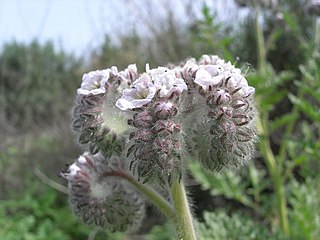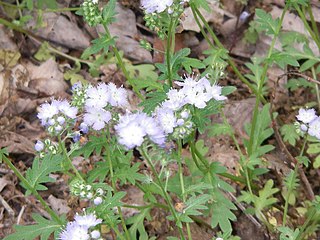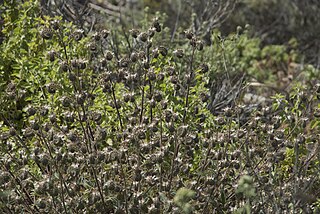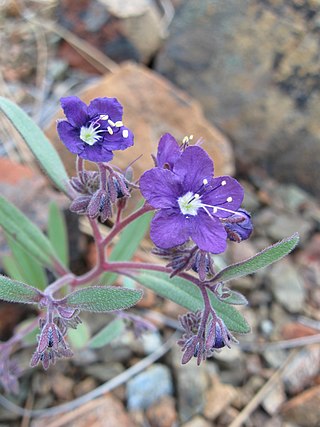
Phacelia cicutaria, with the common names caterpillar phacelia or caterpillar scorpionweed, is an annual species of Phacelia.

Phacelia purshii, known by the common names Miami mist, scorpionweed, and purple scorpionweed, is a spring flowering annual forb with blue, lavender, violet, or nearly white flowers in the Boraginaceae (borage) family that is native to eastern and central North America.

The Russian Wilderness is a wilderness area of 12,000 acres (49 km2) located approximately 65 miles (105 km) northeast of Eureka in northern California. It is within the Klamath National Forest in Siskiyou County and is managed by the US Forest Service. It was added to the National Wilderness Preservation System when the US Congress passed the California Wilderness Act of 1984.
Phacelia adenophora is a species of phacelia known by the common name glandular yellow phacelia. It is native to the northwestern United States where it can be found in Oregon, northeastern California, and northwestern Nevada. It grows in mountain and plateau habitat. This is an annual herb producing decumbent, creeping, spreading, or upright branched stems up to 40 centimeters long. The leaves are oblong in shape and deeply lobed, measuring up to 3 centimeters long, and concentrated at the base. The inflorescence is a one-sided cyme of many bell-shaped flowers each under 1 cm long. The petals are fused at the base with five lobes. Unlike many phacelias, which bloom in shades of blue and purple, this species has yellow to golden flowers. It occasionally has purple edges on the corolla. It has five hairy stamens. The fruit is a fuzzy, oblong capsule a few millimeters in length containing up to 14 seeds.

Phacelia brachyloba is a species of phacelia known by the common name shortlobe phacelia. It is native to southern California and Baja California, where it grows in the coastal mountains, canyons, and valleys. It is one of the many species known as fire followers, that emerge in areas recently burned.

Phacelia breweri is a species of phacelia known by the common name Brewer's phacelia.

Phacelia californica is a species of phacelia known by the common names California phacelia and California scorpionweed. It is native to coastal northern California and Oregon, where it grows in chaparral, woodland, and coastal bluffs and grassland.

Howellanthus is a monotypic genus of flowering plants in the borage family containing the single species Howellanthus dalesianus, commonly known as Scott Mountain phacelia or Howell's phacelia. Until 2010 the plant was known as Phacelia dalesiana. It is endemic to the southern Klamath Mountains of northern California, including the Scott Mountains for which it is named. It grows in mountain forests and meadows often on serpentine soils.

Phacelia douglasii is a species of phacelia known by the common name Douglas' phacelia. It is endemic to California, where it grows in the coastal and inland mountains and foothills, the Central Valley, and the western Mojave Desert.

Phacelia egena is a species of phacelia known by the common name Kaweah River phacelia. It is native to much of California, from the Transverse Ranges to the northern mountains and into Oregon; it also occurs in Arizona. It grows in many types of habitat.
Phacelia eisenii is a species of phacelia known by the common name Eisen's phacelia. It is endemic to California, where it occurs only in the Sierra Nevada and its foothills, as well as the adjacent Tehachapi Mountains. It grows in mountain habitat such as coniferous forests.

Phacelia greenei is a species of phacelia known by the common name Scott Valley phacelia. It is endemic to the southern Klamath Mountains of far northern California, where it is known only from Scott Valley, a valley known for its alfalfa growing, and vicinity.

Phacelia humilis, with the common name low phacelia, is a species of phacelia. It is native to the Western United States, from central Washington to central California, where it grows in mountain and foothill habitat.

Phacelia imbricata is a species of phacelia known by the common name imbricate phacelia. It is native to much of California and Baja California, where it can be found in varied habitat in mountains, desert, valleys, and coastline.
Phacelia inyoensis, the common name Inyo phacelia, is an uncommon species of phacelia. It is endemic to California, in Inyo and Mono Counties, often within the Inyo National Forest.
Phacelia mustelina is an uncommon species of phacelia known by the common names weasel phacelia and Death Valley round-leaved phacelia. It is native to the desert mountains and flats of eastern California and western Nevada, where it grows in woodland and open scrub habitat.

Phacelia nashiana is a species of phacelia known by the common name Charlotte's phacelia. It is endemic to California, where it is known only from the ecotone where the lower Sierra Nevada and Tehachapi Mountains transition into the Mojave Desert. It grows in scrub and woodland and on granite mountain slopes.

Phacelia parryi is a species of phacelia known by the common name Parry's phacelia.
Phacelia saxicola is a species of phacelia known by the common name stonecrop phacelia. It is native to the deserts, hills, and mountain slopes of far eastern California and adjacent sections of western Nevada and Arizona.

Phacelia vallis-mortae is a species of flowering plant in the borage family, Boraginaceae, known by the common name Death Valley phacelia. It is native to the southwestern United States, where it grows in deserts such as Death Valley, and mountain, plateau, and valley scrub habitat.















